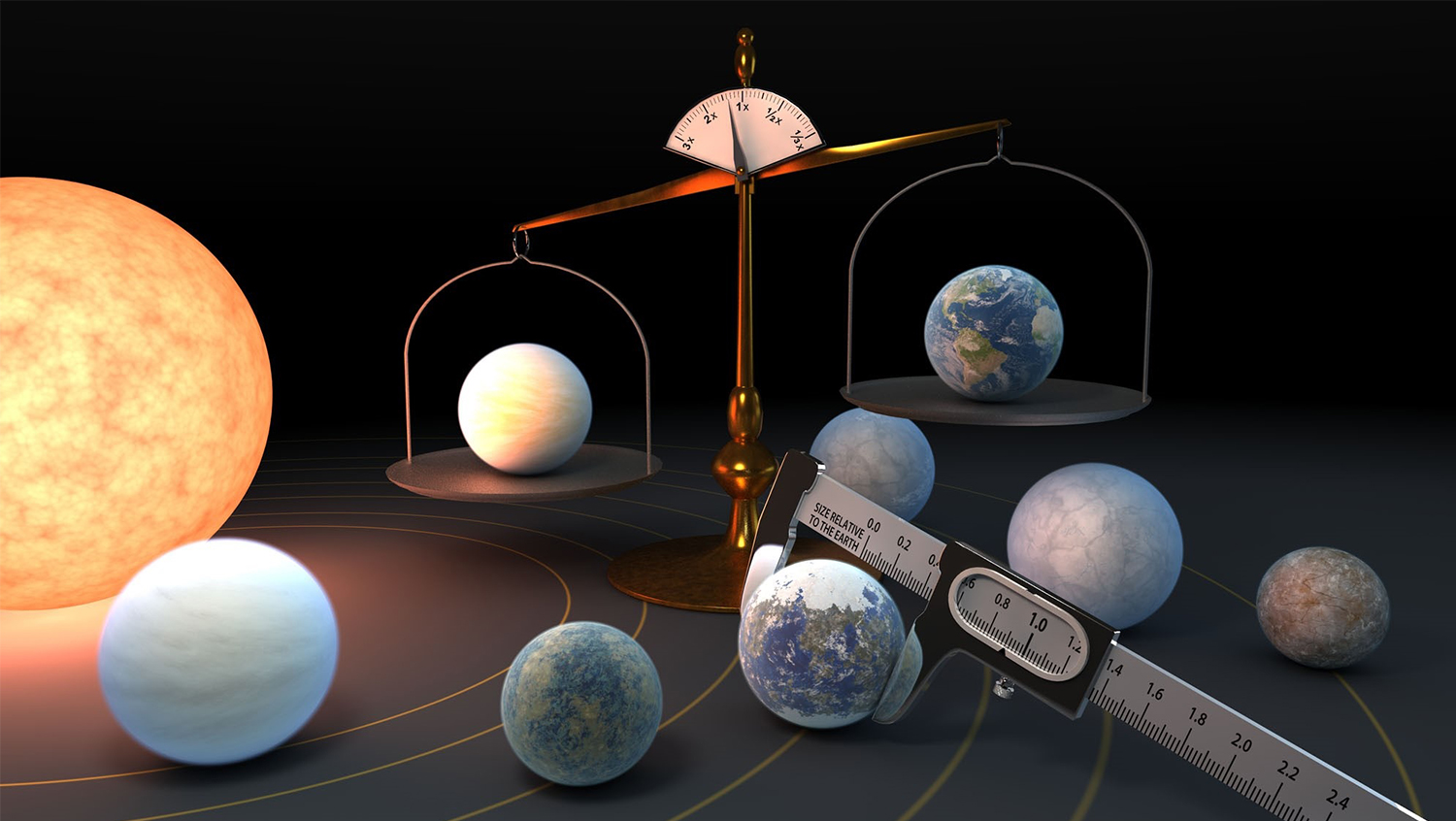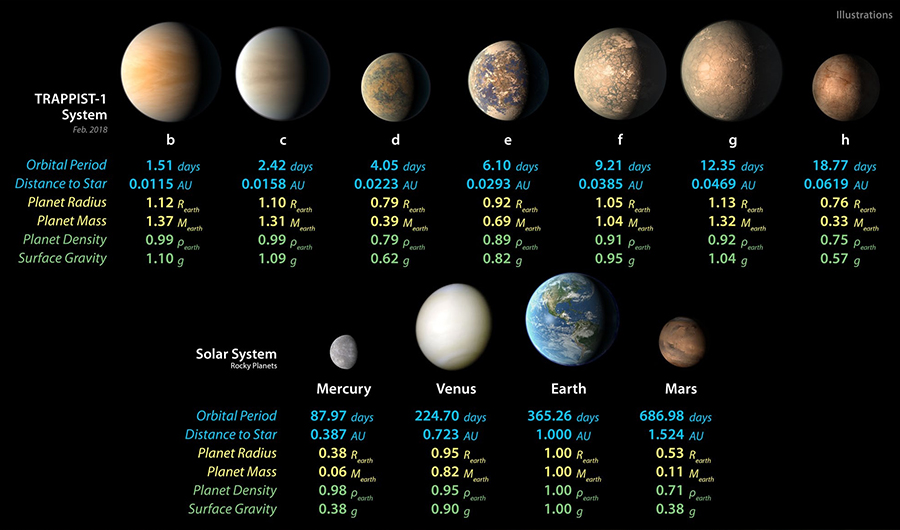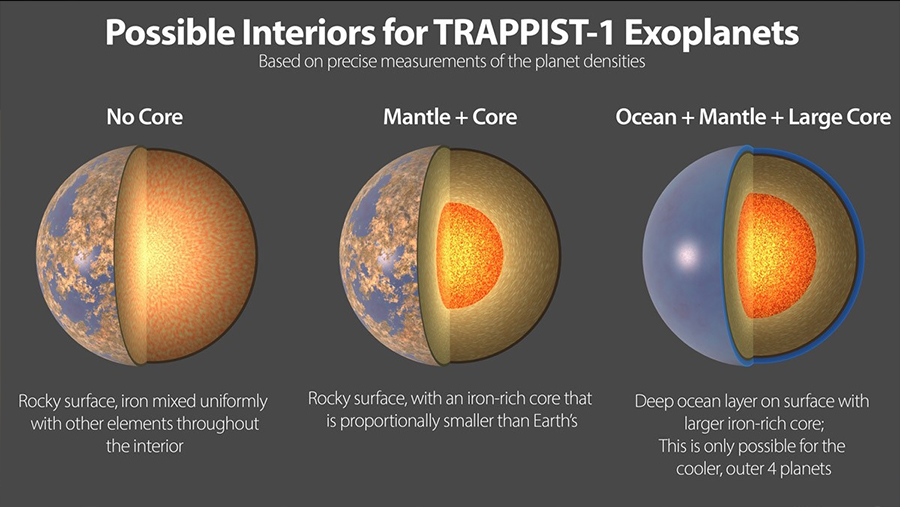TRAPPIST-1 Family of Planets: Rocky Through and Through?
Precise measurements reveal that the exoplanets have remarkably similar densities, which provides clues to their composition
Published Date
By:
- Cynthia Dillon
- Calla Cofield
Share This:
Article Content

Measuring the mass and diameter of a planet reveals its density, which can give scientists clues about its composition. Scientists now know the density of the seven TRAPPIST-1 planets with a higher precision than any other planets in the universe, other than those in our own solar system. Credit: NASA/JPL-Caltech.
The more precisely scientists can measure a planet's density, the more they know about what it’s made of. The TRAPPIST-1 planetary system—home to the largest batch of roughly Earth-sized planets ever found—has offered astronomers a glimpse at the possible diversity among rocky worlds in the universe, including the Earth.
Discovered in 2016 by a team of international scientists, the seven TRAPPIST-1 planets have been studied intensely by astronomers using ground-based and space-based telescopes. New research results, published in the Planetary Science Journal, have synthesized these data to precisely determine the densities of the planets. The scientists’ findings show that all seven planets probably have similar interiors—that are not like the Earth.
The density measurements reported for the TRAPPIST-1 planets were found to vary between identical to Earth and 25 percent lower. However, when the masses of the planets were taken into account, the researchers concluded that they all contain about the same ratio of materials—iron, oxygen, magnesium and silicon—thought to compose all rocky planets.
Notable is the recipe for their composition, which differs from Earth’s. The TRAPPIST-1 planets are all about eight percent less dense than they would be if they had the same composition as our home planet. The precise measurements reported in this study enabled the researchers to hypothesize what mixtures of bulk ingredients could give the TRAPPIST-1 planets their densities, offering the most precise picture of exoplanet innards achieved to date.
UC San Diego’s Adam Burgasser is a co-author on the study and one of the astronomers who has been investigating TRAPPIST-1 since contributing to its initial discovery five years ago. During this time, scientists have studied this planetary system with multiple telescopes, including NASA's retired Kepler Space Telescope and Spitzer Space Telescope. Spitzer provided more than 1,000 hours of targeted observations of the system before being decommissioned last year.

A planet’s density is determined by its composition as well as its size: Gravity compresses the material a planet is made of, increasing the planet’s density. Uncompressed density adjusts for the effect of gravity and can reveal how the composition of various planets compare. Credit: NASA/JPL-Caltech.
“The TRAPPIST-1 system is truly remarkable because all seven planets were found by the transit method,” explained Burgasser. “The planets pass between us and their host star, which we detect by a small dip in the star’s brightness. And while we cannot see the planets directly, these transits provide a clever way to measure both radius and mass, and hence average density, for every one of these worlds.”
Repeated observations of the starlight dips, and precise measurements of their timing, is the trick. The depth of the dips measures each planet’s radius relative to the star. The timing of the dips—usually perfectly synched with the orbit of the planet—actually varies as the planets pull on each other through gravitational forces.
“The planets give small tugs on each other as they pass by, and as a result they speed up or slow down in the orbits,” explained Burgasser. “We can measure these interactions with our transit timing measurements, and because these shifts are caused by gravitational force, which depends on mass, the timings allow us to determine the planets’ masses using Newton’s Laws.”
Iron's Reign
In our own solar system, the densities of the eight planets vary widely. The puffy, gas-dominated giants—Jupiter, Saturn, Uranus and Neptune—are larger, but much less dense than the four terrestrial worlds. Earth, Venus and Mars have similar densities, but Mercury contains a much higher percentage of iron. Even though it is the solar system's smallest planet in diameter, Mercury has the second highest density of all eight planets after the Earth.
The seven TRAPPIST-1 planets, on the other hand, all appear to have similar compositions, which makes the system quite different from our own. And while the eight percent difference in density between the TRAPPIST-1 planets and Earth, Venus and Mars may seem small, it is significant on a planetary scale. For example, one explanation is that the TRAPPIST-1 planets have a similar composition to Earth, but with a lower percentage of iron—about 21 percent, compared to Earth's 32 percent, according to the study.

Shown here are three possible interiors of the TRAPPIST-1 exoplanets. The more precisely scientists know the density of a planet, the more they can narrow down the range of possible interiors for that planet. All seven planets have very similar densities, so they likely have similar compositions. Credit: NASA/JPL-Caltech.
“Less iron in the core could reduce the generation of magnetic fields around the planets,” said Burgasser. “This is important for habitability, as the Earth’s magnetic field is one of the protective barriers to high energy particles from the Sun.”
Alternatively, the iron in the TRAPPIST-1 planets might be infused with high levels of oxygen, forming iron oxide, or rust. The additional oxygen would decrease the planets' densities. The surface of Mars gets its red tint from iron oxide, but like its three terrestrial siblings, it has a core composed of non-oxidized iron. By contrast, if the lower density of the TRAPPIST-1 planets were caused entirely by oxidized iron, then the planets would have to be rusty throughout and could not have pure iron cores.
Eric Agol, an astrophysicist at the University of Washington and lead author of the new study, said the answer might be a combination of the two scenarios—less iron overall and some oxidized iron.
The team also looked into whether the surface of each planet could be covered with deep oceans of water, which is even lighter than rust and which would reduce the planet's overall density. If that were the case, water would have to account for about five percent of the total mass of the outer four planets. By comparison, water makes up less than one-tenth of one percent of Earth's total mass. The three inner TRAPPIST-1 planets, positioned too close to their star for water to remain a liquid under most circumstances, would need to have hot, dense atmospheres like on Venus, where water could remain bound to the planet as steam. However, Agol says this explanation seems less likely as it would be a remarkable coincidence for all seven planets to have just enough water to have such similar densities.
"The night sky is full of planets, and it's only been within the last 30 years that we've been able to start unraveling their mysteries," said Caroline Dorn, an astrophysicist at the University of Zurich and another co-author on the paper. "The TRAPPIST-1 system is fascinating because around this one star we can learn about the diversity of rocky planets within a single system. We can actually learn more about a planet by studying its neighbors as well, so this system is perfect for that."
Support for this work came from NASA through an NSF award issued by JPL/Caltech (grant no. AST-1615315), through the Exostar19 program at the Kavli Institute for Theoretical Physics at UC Santa Barbara (grant no. NSF PHY-1748958); through NExSS Virtual Planetary Laboratory, under NASA Astrobiology Institute Cooperative (agreement no. NNA13AA93A) and the NASA Astrobiology Program (grant no. 80NSSC18K0829). TRAPPIST is a project funded by the Belgian Fonds (National) de la Recherche Scientifique, F.R.S.- FNRS (grant no. FRFC 2.5.594.09.F). TRAPPIST-North is a project funded by the University of Liége, in collaboration with Cadi Ayyad University of Marrakech (Morocco); the Swiss National Science Foundation (grants PP00P2-163967, PZ00P2_174028, and 200020_19203, respectively). Calculations were performed on UBELIX (http://www.id.unibe.ch/hpc), the HPC cluster at the University of Bern.
This work was carried out in the framework of the PlanetS National Centre of Competence in Research (NCCR), supported by the Swiss National Science Foundation, and the research made use of NASA’s Astrophysics Data System and of services produced by the NASA Exoplanet Science Institute at the California Institute of Technology. The project received funding from the European Union’s Horizon 2020 research and innovation program under the Marie Sklodowska-Curie Grant (agreement no. 832738/ESCAPE) and the European Research Council (grants agreement nos. 679030/WHIPLASH and 803193/BEBOP). Other supporting institutions include the Gruber Foundation, the European Research Council under the European Union’s Seventh Framework Programme (FP/2007-2013, ERC grant (agreement no. 336480), and from the ARC grant for Concerted Research Actions, financed by the WalloniaBrussels Federation, and from NASA (grant no. 80NSSC18K0397) and the Washington NASA Space Grant Consortium Summer Undergraduate Research Program.
Share This:
You May Also Like
Stay in the Know
Keep up with all the latest from UC San Diego. Subscribe to the newsletter today.



